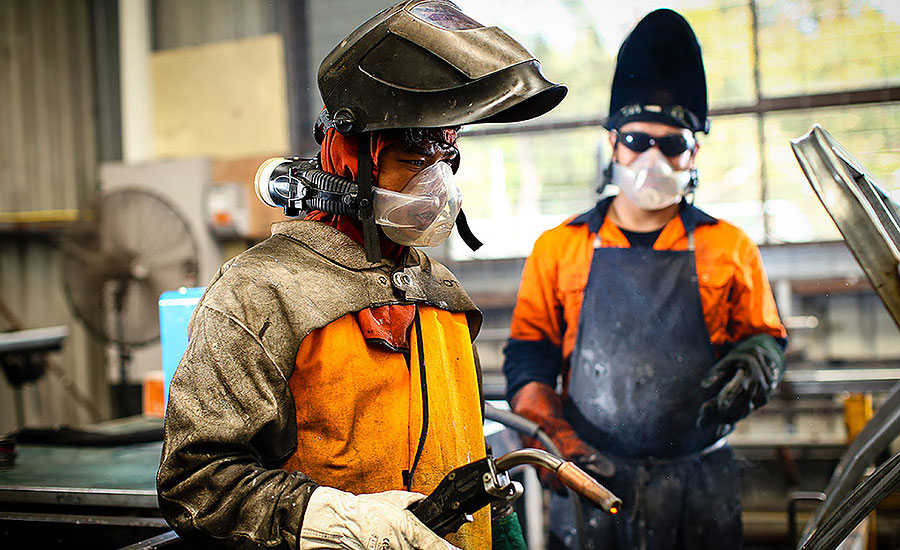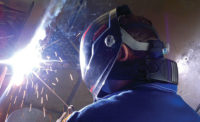When it comes to workplace safety, welders are well aware that their profession is one of the most dangerous. Welders face an array of hazards from electric shock, retinal damage, ocular melanoma, or serious burns. One of the silent dangers that can be difficult to tackle is the array of toxic fumes welders can be exposed to on a daily basis.
Research has shown that metal fabrication and shipyard workers, exposed to the chemical element manganese through welding, have displayed Parkinson’s disease-like symptoms. Fume fever can affect welders exposed to zinc, copper, magnesium and cadmium. Persistent pulmonary bronchitis is the most frequent chronic problem and there are case reports of interstitial fibrosis in welders from exposure to excessive welding fume concentrations. Shockingly, welders have a 44 percent increased risk of developing lung cancer (1), an increased risk of kidney disease and lower fertility rates.
Toxic mixture
Welding smoke is a mixture of very fine particles and gases. Many of the substances in welding smoke, such as chromium, nickel, arsenic, asbestos, manganese, silica, beryllium, cadmium, nitrogen oxides, phosgene, acrolein, fluorine compounds, carbon monoxide, cobalt, copper, lead, ozone, selenium, and zinc, can be extremely toxic.
With such an array of potentially toxic fumes, welding areas require adequate ventilation and local exhaust to keep fumes and gases from the breathing zone and the general area. In most situations, employers will provide a ventilation system- such as a fan, and an exhaust system to remove fumes and gases from the work area. But in many situations, more protection is required.
Hierarchy of Controls
Current regulations require employers to have a respiratory program (OSHA 29 CFR 1910.134) that includes medical clearance, training and fit testing. To reduce the risk of illness, injuries and even death the National Institute of Occupational Safety and Health-NIOSH developed a broadly accepted “Hierarchy of Controls” to help in the planning and engineering of work environments.
A respiratory program will be based on eliminating or controlling the workplace contaminants with a system of control. (CDC/NIOSH) (2):
- Elimination: The goal in any workplace should be to eliminate the hazard verses just protecting against it. In an ideal situation physically removing the hazard is the most effective hazard control, such as eliminating the need to weld or providing machinery that removes the worker from the environment.
- Substitution: Involves replacing something that produces a hazard (similar to elimination) with something that is less hazardous, such as replacing the welding material or metal with something with reduced toxic impact or risk.
- Engineering Controls: Engineering controls isolate people from the hazard, such as local ventilation at the source of the hazard. This is seen most often in welding with the use of vents, hoods and extractors.
- Administrative Controls: Administrative controls change the way people work to minimize the exposure. Examples include procedural changes, employee training and installation of signs and warning labels.
- Personal Protective Equipment (PPE): PPE is the last control and is worn to minimize or prevent exposure if the above controls cannot be implemented - PPE includes half or full face respirators and helmets.
Making the right choice
Welders have a personal responsibility to ensure the recommended PPE is provided and to wear it correctly. Respiratory PPE is technically complex and a potentially confusing area that if you get wrong, could have permanent impact to health. There are two kinds of respirators – negative pressure respirators and positive or powered air purifying respirators (PAPRs) and airlines.
- Negative Pressure Respirators: These are respirators that do not have a motor/fan and rely on the wearer to breathing through a filter on the face. There are either disposable (N, R or P95) or reusable masks with P100 P100/HEPA cartridges. Some of the challenges with disposables are poor protection (if not fitted correctly), compliance (hot, breathing resistance, fogging), and the high consumable costs, waste and disposal.
- Positive or Powered Air Purifying Respirators (PAPRs) and Airlines: These respirators have a motor/fan or supplied air (airline).
When welders are choosing their respiratory PPE, the usual considerations are:
- Protection: Is the welder working in confined spaces, what is the exposure time, what are the air quality levels. Some employers are now mandating that PAPRs or airlines must be worn with all welding applications. This makes the choice simpler. In confined spaces airlines or SCBA must be worn due to the potential for lack of oxygen.
- Comfort: Respirators may be needed for long periods of time and during high temperatures. Comfort, breathability and cool air are extremely important to ensure a welder is focused and able to complete the welding task at hand. The respirator needs to fit comfortably with a welding mask and it needs to be light.
- Costs: For large welding operations or long periods of wear, disposable masks are not economic and considered an expensive and, more importantly, a low-protection option.
Reference
- James M. Antonini, “Health Effects of Welding.” Critical Reviews in Toxicology. Vol. 33, No. 1 (2003), pp. 61-103.
- System of control for eliminating or reducing workplace Hazards – CDC/NIOSH






